Art World
How the Audacious Art of Geta Brătescu Inspired Akris’s Spring/Summer 2019 Collection
Albert Kriemler, Akris's creative director, tells us about his collaboration with the great Romanian Conceptual artist.
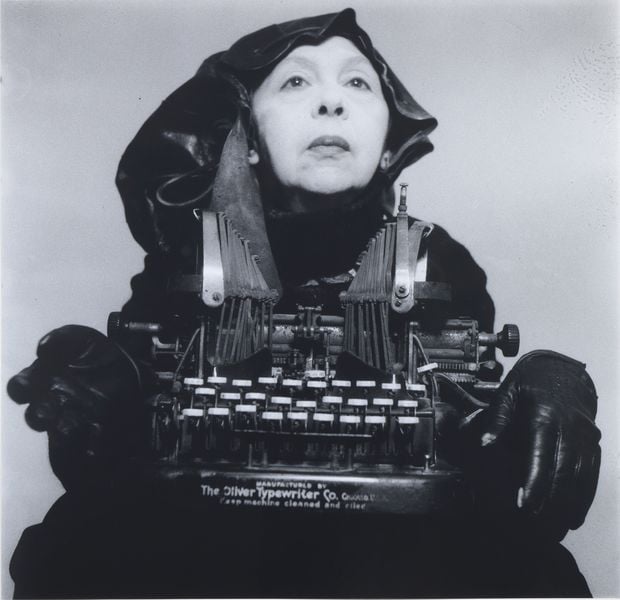
Albert Kriemler, Akris's creative director, tells us about his collaboration with the great Romanian Conceptual artist.

Nazanin Lankarani

Last fall Albert Kriemler, the creative director of the Swiss fashion house Akris, showed a collection on the Paris runways that captured the joie de vivre of Geta Brătescu, who for seven decades was a vital figure on the Romanian art scene. Brătescu’s multimedia work, often steeped in mythology, is celebrated for its playful circumvention of the socialist realism mandated by her country’s repressive regimes during the Communist years, and for her steadfast avoidance of “isms.”
The artists Kriemler has chosen to collaborate with—including Thomas Ruff and Rodney Graham—have opened new creative doors for him, as his designs have shone a fresh spotlight on the intricacies of their work. For his Spring/Summer 2019 collection, for example, Kriemler took the draping of a silk dress and the soleil-plissé of a skirt and added new colors, digitally printed images, and embroidered scribblings, simultaneously drawing references from Brătescu’s oeuvre and disrupting the familiarity of classic looks. He did this, of course, without compromising the modern sophistication that defines the Akris style.
In her diary, Brătescu once wrote: “When I draw, I tell a story about forms. No matter what the ‘object’ of my attention might be, the drawing narrates spatial postures, it records the track of the movements in space made by volumes or lines, linear objects.” Those words could easily apply to Kriemler’s visual sense and rigorous tailoring.
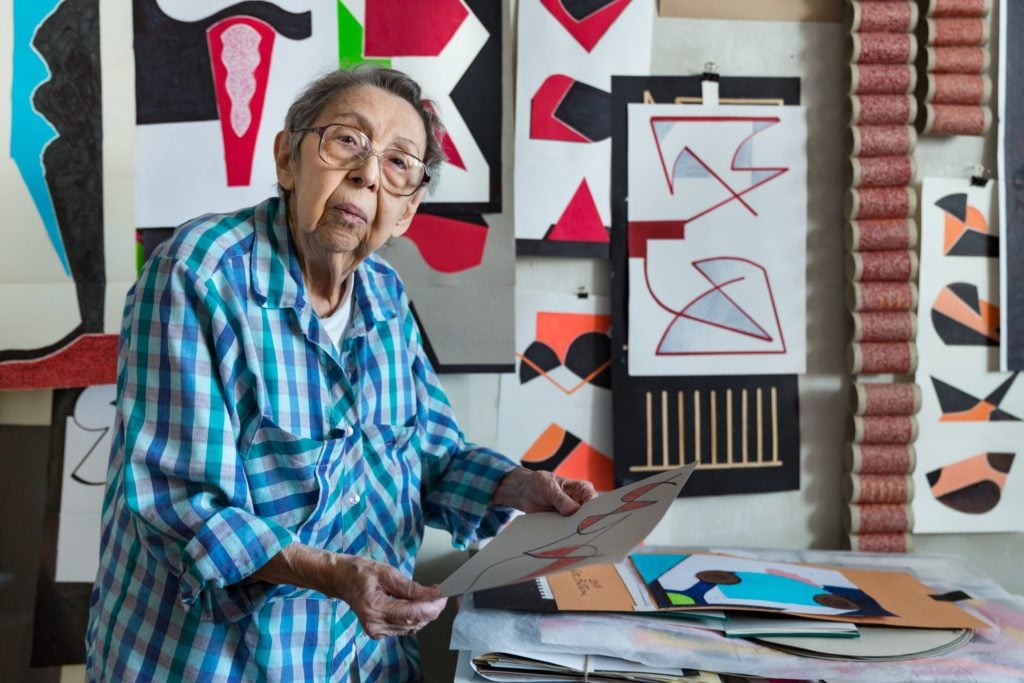
Geta Brătescu. Photo by Cătălin Georgescu. Courtesy of the artist, Hauser & Wirth, and Ivan Gallery.
Brătescu died at the age of 92 on September 19, 2018, just days before Akris unveiled its collection. On a recent visit to Akris’s elegant Parisian showroom, artnet News discussed with Kriemler the collaboration that became an homage, and how he found in Brătescu’s photomontages and her fixation with lines and colors inspiration for a collection brimming with gentle and joyful femininity.
How did you first discover the work of Geta Brătescu?
Every collection starts with a feeling. I first saw Geta Brătescu’s work in 2017 at documenta. In her “Linia” collages, which were a series of painted pink shapes and black lines, she had used an exceptional shade of pink that I found quite intriguing. I started reading about her. At Art Basel that same year, I saw more works by Geta. Again, her sense of color struck me: the pinks, the red, the natural shade of cardboard, and that re-used paper that she liked so much. Hauser & Wirth connected me with her Bucharest gallerist, Marian Ivan. He was like a stepson to her and had guided Geta through the last five years of her life.
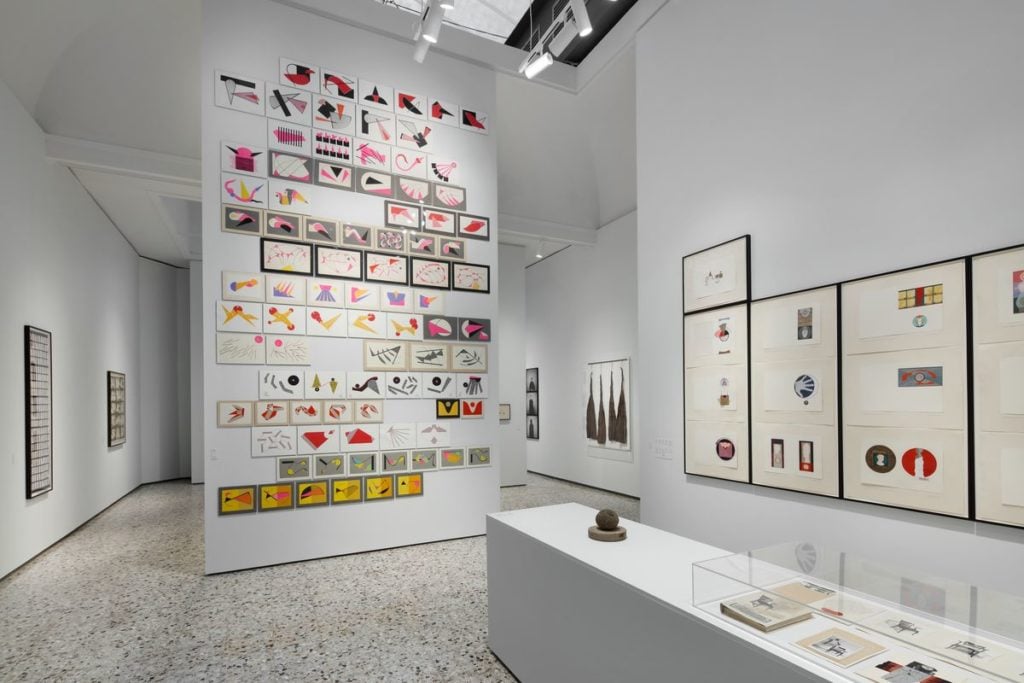
Installation view, “Apparitions” at the Romanian Pavilion at the 2017 Venice Biennale. © Geta Bratescu. Photo: Jens Ziehe.
How did you approach Brătescu for a collaboration?
I traveled to Bucharest in January 2018. She invited me to her home where she also had a studio in which she still worked every day. Geta had the kind of life spirit that made you smile. She was full of energy and had an incredible joy for life and a remarkable sense of humor. After speaking with her for about two hours, I asked if she would agree to have me choose some of her pieces for a collection, and for us to do a collaboration. She said she would accept but that she would have to be in control!
I loved that. For me, fashion is not about a superficial venture where a designer takes inspiration from a random source. Some designers take advantage of an artist’s name and never actually get involved with that artist. That is not how I work.
To what extent did Brătescu “control” your creative process?
Geta asked for control, and I welcomed the challenge. Her gallerist, Marian, came to our workshops in St. Gallen and quickly realized that we were doing something good. For me, it is important to have an interaction with the artist. I wanted Geta to tell me what she thought of my work. I always show my pieces to the artist before they go on the runway. It is being respectful, and I want the artist to feel good about the collaboration. But at the end of the day, the collection reflects my own individuality in selecting the artist and my personal feeling about whether a particular design will work.
Why did you open the show with the “Magnets in the City” series?
It was Geta’s wish that I work on her Magnets photomontage series from the 1970s. She asked for it, so I made it my mission. She went to great lengths to explain the power of magnetism. When magnetism works, it is a love affair, she said. The images from her series were printed on a few of my pieces, namely the soleil-plissé print dress, and we used magnets for the closure of some jackets and on some accessories.
As for prints, I had decided a few years ago to bring a special awareness to prints by developing a print-based handwriting. Since then, my signature prints have become collector’s pieces. As you know, in 2007, I was the first to do digital prints with my first art-inspired collection. Everyone felt that they were sensationally different.
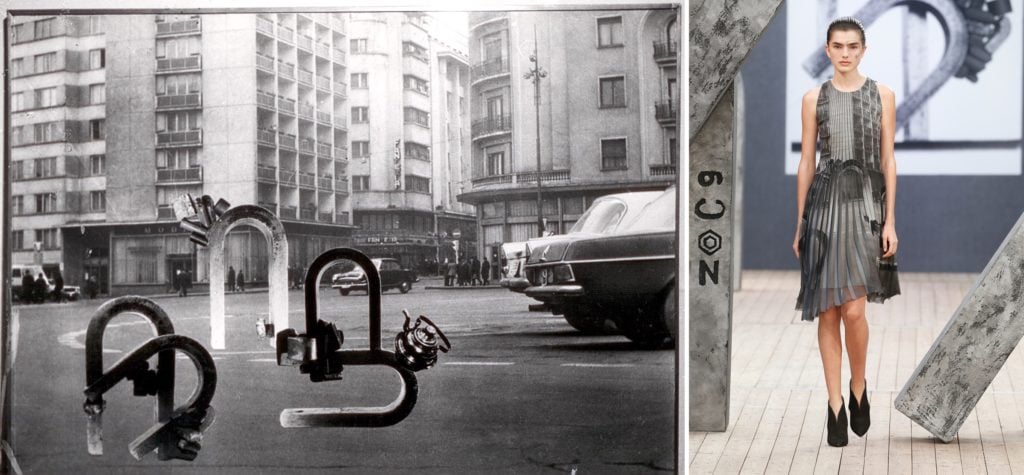
Left: Geta Brătescu, Magnetii in Oras (Magnets in the City) (1974). Courtesy Hauser& Wirth. Right: A look from Akris SS19 Runway Show. Courtesy of Akris.
Did Brătescu’s aesthetics work well with your own signature style?
The colors we developed were fantastically well received. The two shades of pink—that unique “Geta” pink and a softer “Bellini” shade—combined with the black made for some of the chicest and sleekest interpretations of Geta’s “Linia” series.
I also chose Geta’s “predatory fish” motif, which had a very strong graphic line. Elements from Geta’s Self Portrait from 2011 are in the yellow poncho with the eyes and lips, and on handbags. Geta’s “Crazy Line” drawings were translated into the Leparello print coat with embroidery.
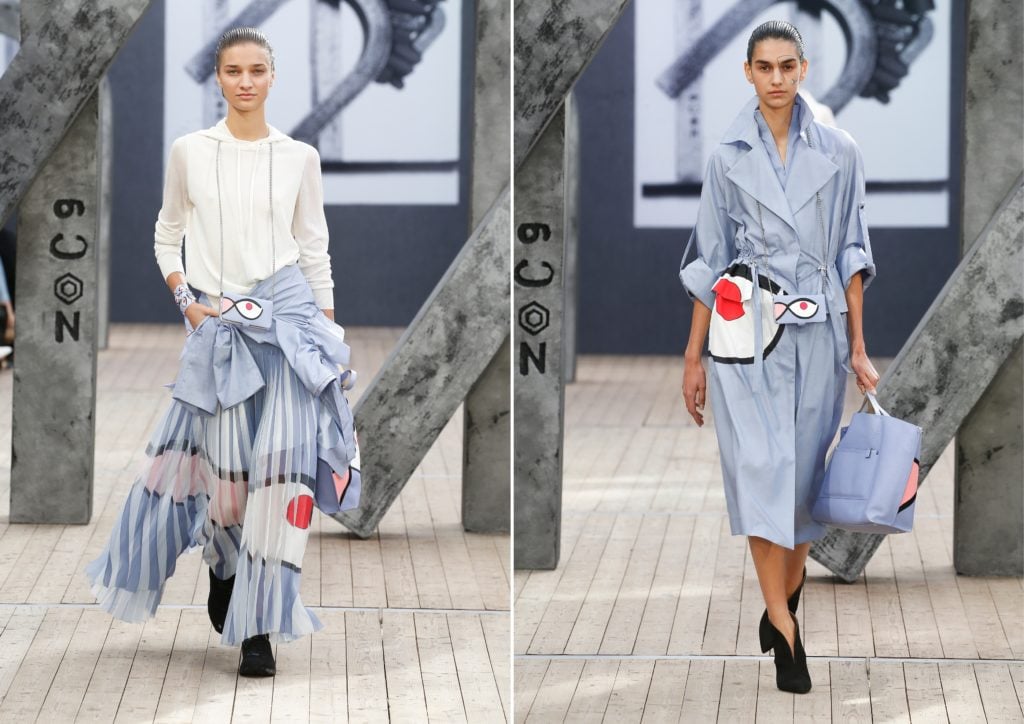
Akris SS19 Runway Show. Courtesy of Akris.
You collaborate with artists, but are you not constrained by practical considerations?
Artists only focus on self-expression and on their own art. As a designer, I want women to actually wear my clothes. So as the artist Thomas Ruff once put it, the designs are my responsibility, and I always make choices that I know will appeal to our clients.
Do your clients appreciate the freedom with which you design each new collection?
My clients look at my pieces and decide whether it speaks to them, regardless of whether they know where the inspiration came from. In this collection, Geta’s colors were something of a challenge, but the collection was very well received in the end. Do you know that I got the nicest compliment after the show? I was told I was “a color master.”
Obviously, there are always clients who know more than others about art. I am lucky to have a staff that gets excited about our artist-inspired collections. We deliver a certain knowledge with these collections. I look at these collaborations as a way of writing a seasonal history. When people react so positively to these collections, I feel that I can do so much more. That is what creation is all about for an artist or a designer.
See more images from Akris’s Spring/Summer 2019 Collection, inspired by Geta Brătescu’s work, below.
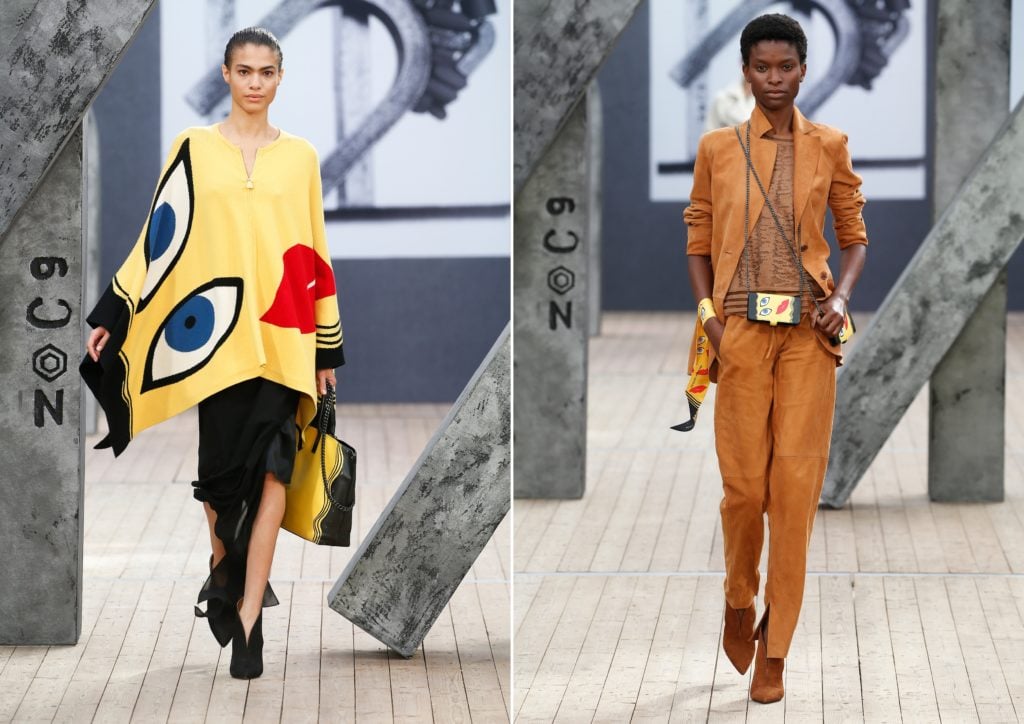
Akris Spring/Summer 2019 Runway. Courtesy of Akris: Elements from Bratescu’s Self Portrait (2011) seen in yellow poncho and handbag.
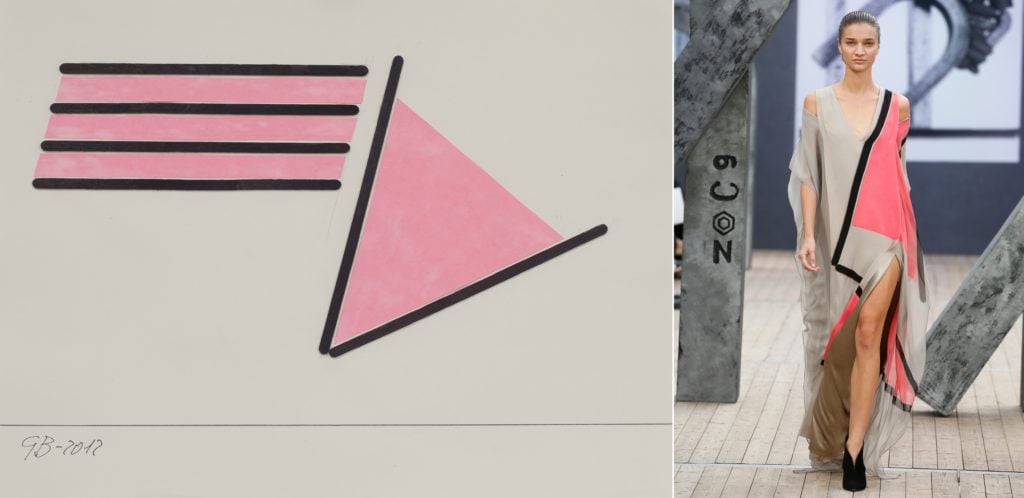
Left, Geta Bratescu’s “Linea” series. Right: Spring/Summer 2019, courtesy of Akris.
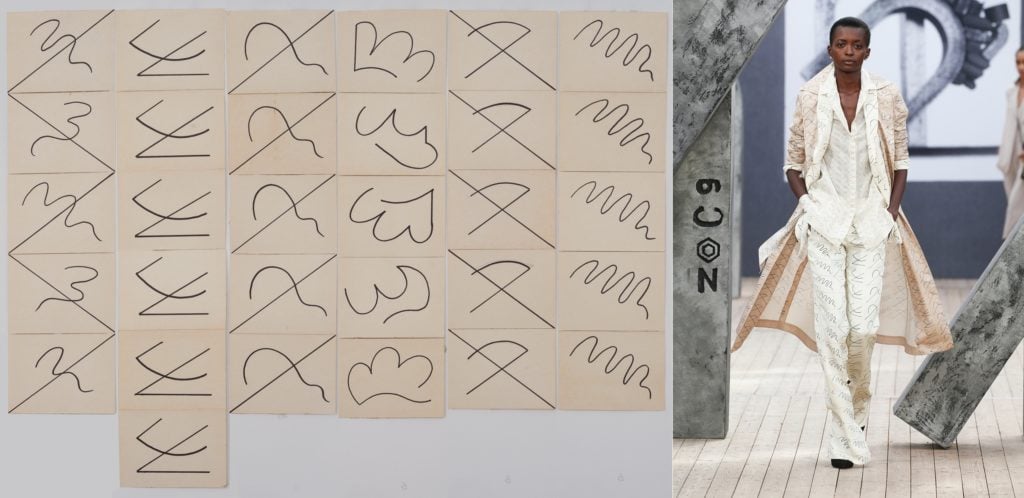
Geta Bratescu’s Linia (2014) and the runway look it inspired. Courtesy of Akris.